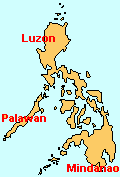Status of the World Dugong Population by Country
(3 of 4)
Philippines

A baby dugong reared as a family pet in Romblon |
The Philippines once had a rich population of dugong which has decreased to a relict in the last decades. But the country has started a remarkable rescue program for the animal, with special emphasis on the education of the population and the release back of dugongs accidentally trapped in fish corrals or caught in fish nets.
As of 1997, they have been seen and confirmed only from the Palawan Province, Romblon Island, Guimaras Island, and Pujada Bay in Davao Oriental (with only one specimen from the last three areas). Viable populations may still be present in the eastern Luzon coast (Isabela to Quezon) and southern Mindanao to the Tawi-Tawi Islands. They are probably extinct and extremely rare in the western coast of Luzon, northern Mindanao, and the Visayas (Kataoka et al., 1995 and Pawikan Conservation Project Reports). There are indications that dugongs were still present in most regions of the Philippines until the late 1970s. Most information are only anecdotal reports from fishing communities.
There is no population count for the Philippines. The present population in the country is described as sparse and low density by Trono et al (1993), Nishiwaki et al. (1979), Nishiwaki and Marsh (1985) and PCP reports.
Most historical accounts of dugongs were from direct catches. Dugongs were slaughtered because they provide high quality meat which tastes like veal. The meat was usually sun dried or cooked immediately. It was priced at around Php 10 to 30 per kg. The hide, blubber, and innards were consumed as well. The bones and teeth were thought to possess medicinal properties and were used in treating ailments such as indigestion and asthma. These were also used as ornaments.
They were previously hunted using nets, prong, hook, spear, harpoon, and dynamite. Today, hunting dugongs is not practiced anymore, even in Palawan where most dugongs are found. Although some fishers will not pass off an opportunity to catch a dugong. Meat was previously sold openly in public markets up until the time when it became prohibited, but obscure vending still persists (Yaptinchay, 1994).
Almost all catches today are incidental and fishing nets are the primary cause. Gill nets, seines, trawls, and bag nets have been identified to have caught dugongs. A fishing device called the fish corral, locally known as baklad, captured dugongs as well. Stranding of dugongs after a strong typhoon or of injured individuals have also been reported.
This has contributed significantly to the decline of our dugong population. There are no quantitative data on mortality estimates due to lack of monitoring capabilities.
Conservation Activities in the Philippines

Japanese scientists conducted surveys and capture operations in the country in the late '70s (Kamiya et al., 1979; Kataoka and Asano, 1980). Studies on dugongs in the country in the '80s include unpublished reports by Alcala (1986) and Aragones (1990). In 1985 , Toba Aquarium in collaboration with the Pawikan Conservation Project (PCP), Protected Areas and Wildlife Bureau (PAWB), Department of Environment and Natural Resources (DENR) conducted survey and capture operations in northern Palawan. Two dugongs captured from these activities are currently displayed and studied in the Aquarium in Toba City, Japan (Kataoka et al., 1995).
Aerial surveys and interviews were conducted throughout Palawan which contributed significantly to the limited information available on dugongs (Trono, 1985).
With the available data, the grievousness of the condition of the dugong population in the country was evident. And this is aggravated by the lack of more information and the continued exploitation of the animal.
In 1991 , dugong conservation took a leap with the issuance of DENR Administrative Order No. 55, which made the dugong the first marine mammal protected in Philippine waters. As stipulated in this AO, any person who shall hunt, kill, wound, take away, possess, transport and/or disposes of a dugong, dead or alive, its meat or any of its by-products shall be punished by imprisonment from 6 months to 4 years or fined Php 500 to 5,000 or both.

Dr AA Yaptinchay rescuing a dugong caught in a fish trap |
The order mandated the PCP to spearhead the implementation of a nationwide program to conserve dugongs. The PCP embarked on the following major activities: Research, Resource Management, and Information Education Campaigns (Palma and Yaptinchay, 1995).
To date, information and education seminars have been conducted in the whole province of Palawan and some other regions, posters and primers have been produced and distributed (de Veyra, 1995), and surveys are carried out throughout the country.
Rescues of live captured dugongs have been carried out with the successful release of at least 6 dugongs in Palawan back to the wild between 1992 and 1996 (Yaptinchay, 1995). Several fishermen were also fined for the slaughter of dugongs in Palawan. Most important, two bays in Palawan with high sighting and capture reports have been proposed as dugong sanctuaries.
Agencies involved in dugong research and conservation are the DENR, University of the Philippines, and Kabang Kalikasan ng Pilipinas.
Present Issues.- Funding for research and conservation activities is minimal;
- Lack of knowledge on the distribution of dugongs in the country and no population estimates;
- There are no data on the impact of human activities on the dugong and its habitat;
- Monitoring of dugongs in critical areas is not effected,
- Researches and conservation activities have been concentrated in Palawan alone and other areas which may still have a significant population are not given attention
- incidental mortalities still occur and the meat is still consumed
- the law protecting the animal is not strictly implemented
- development and encroachment of people in areas which harbor dugongs
- Population in the country may be too low that they are already considered ecologically extinct.
Photos courtesy of:
- PCP, the Pawikan Conservation Project (the baby dugong)
- WWF-Philippines (the rescue)
South Asia <<